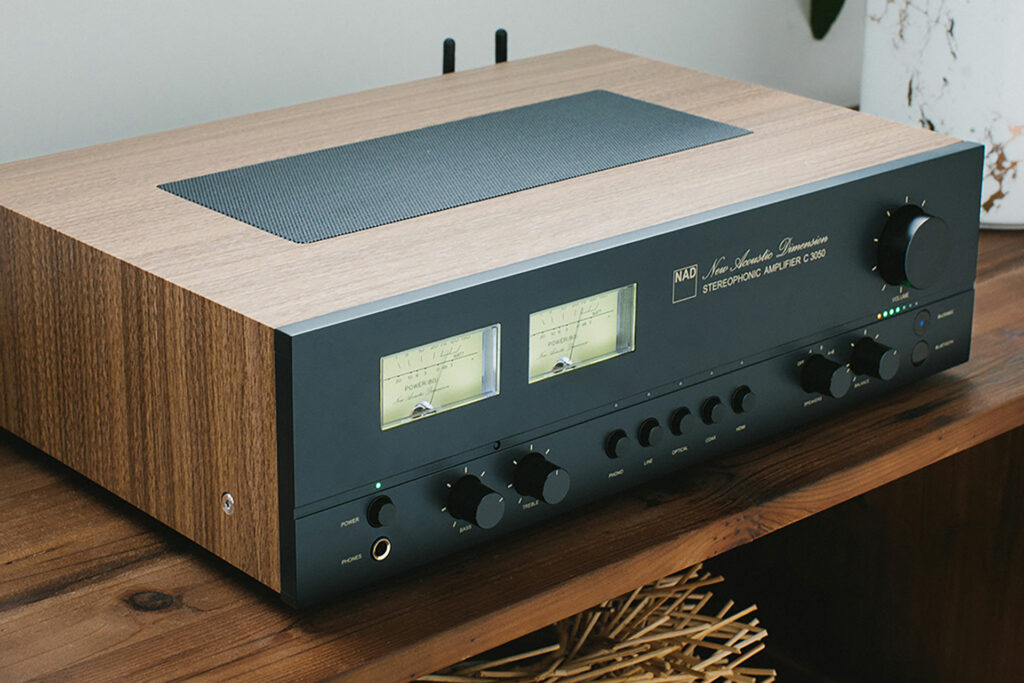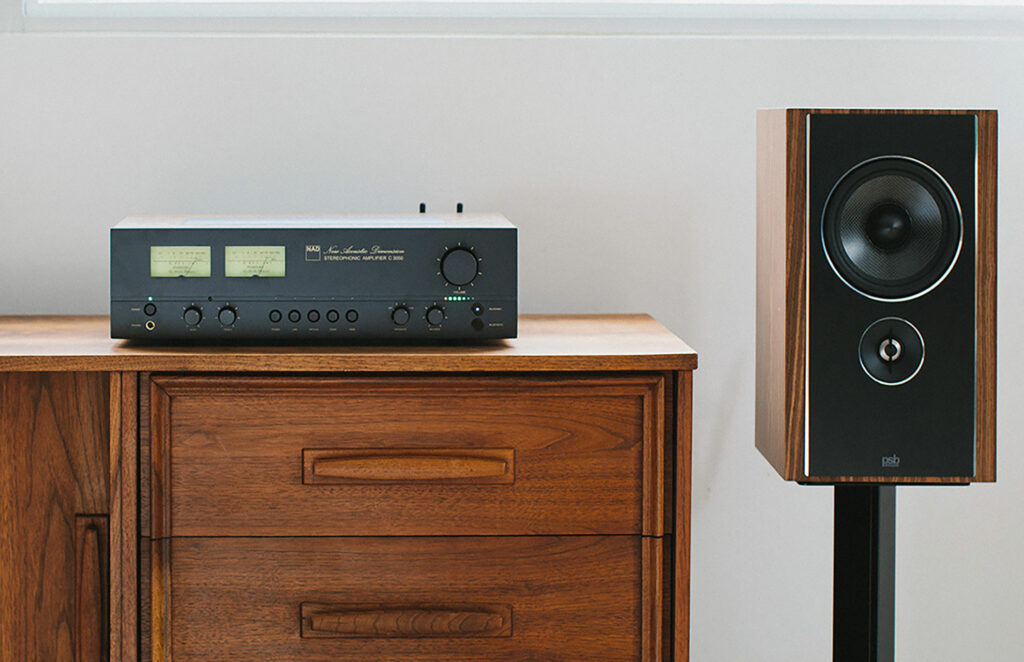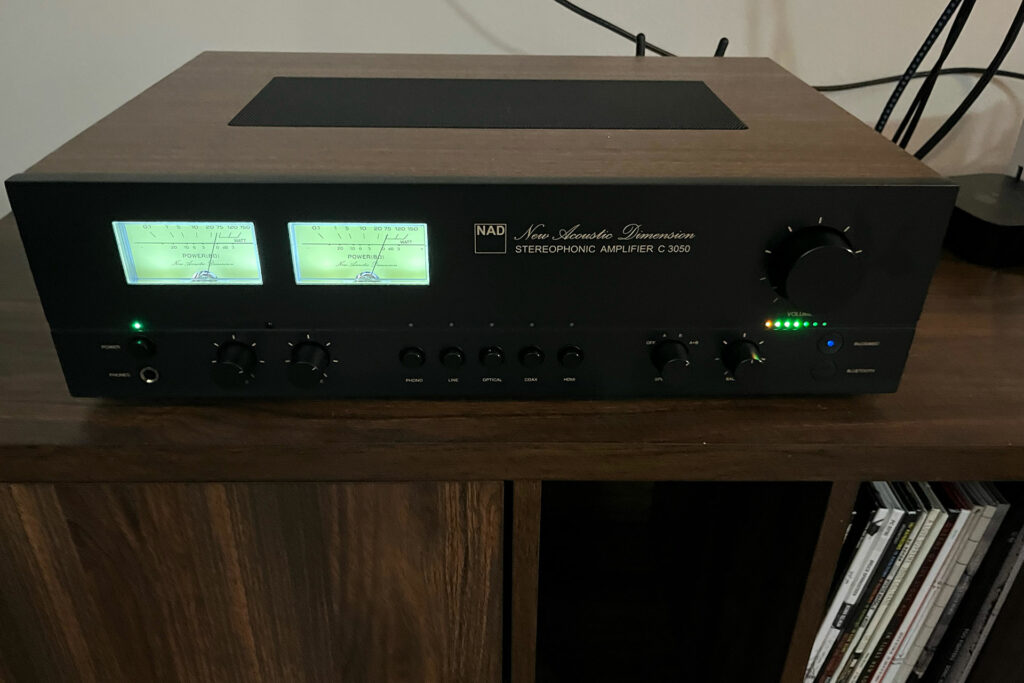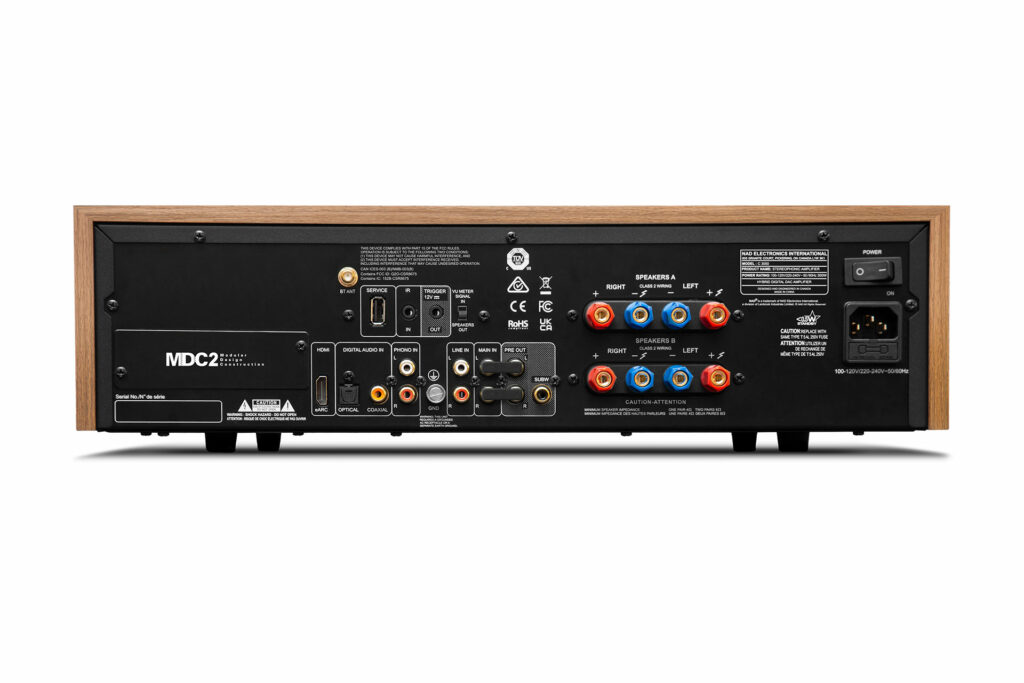The 3050 may be NAD’s newest audiophile integrated amplifier, but it takes little more than a casual glance to see that it’s been inspired by some of their most meaningful legacy products – ones that helped guide the first steps of countless audiophile journeys. Don’t be fooled by vintage vibe of is the cabinet, though, as the amp is anything but vintage under the hood. The NAD C 3050 ($1,399 buy at Crutchfield) features 100 watts of class D power, along with a 32-bit/384kHz DAC, HDMI eARC , aptX Bluetooth support, and all the other most modern integrated amps provide, like optical in, coax in, analog in, and a phono input. Also, if you want more power, NAD gives you a pre-out. If that isn’t enough for you, you can also add an additional module to the unit that adds BluOS streaming and Dirac room correction.

What Makes the NAD C 3050 Integrated Amplifier Special?
- The features of this integrated amp are hard to match at any price point in the audiophile space even when looking at sophisticated stereo preamps let alone other integrated amps. HDMI, room correction, and Bluetooth merely scratch the surface.
- With this integrated amp being able to do so much, it’s fantastic that NAD lets you add the only thing an audiophile might find missing: more power. By setting it up with a preamp output, you can then add a dedicated amplifier to up the output or switch to a different topology, if you prefer. That isn’t to say that 100 watts of power isn’t enough– for most people it is – but if you find yourself with some large three-way towers in a large space and need more current, you might want to keep an NAD C 3050 around as a front end but matched with a more beefy amp someday.
- Room correction is starting to find itself into more and more integrated amps and preamps, so it’ great to see it available in this affordable NAD. It’s far from common, but buying physical room treatments can be costly, and it isn’t always as stylish as you might want it to be, so getting digital room correction is a welcome addition for many people.
- Some audiophiles dismiss HDMI but they absolutely shouldn’t, as mainstream sources like Apple TV, Roku, and disc players all connect easily and neatly via HDMI and provide good audio as well as video. Most audiophile companies won’t spend the licensing fees for HDMI to go in their products. Others just don’t want to deal with video at any level whatsoever. Thankfully, NAD sees that enthusiasts, as well as mainstream users, like having every possible option and feature at their fingertips.

Why Should You Care About the NAD C 3050 Integrated Amplifier?
I’m not sure I’ve ever seen so many features packed into one audiophile component. NAD makes it so that the stereo preamp section can literally do it all, and I seriously mean all. If you look at the competition, it is really hard to find anything that comes even close to matching up, and it isn’t just that it has so many things in the box; it’s also that the box sounds great. I have reviewed at least half a dozen integrated amplifiers this year from multiple brands, and each time I felt like the product would have been better if they had added something. With the NAD C 3050, I never found myself having that thought. Everything I could have asked for was there.

Some Things You Might Not Like About the NAD C 3050 Integrated Amplifier
- The retro aesthetic isn’t going to be for everyone. NAD is honoring its history with this piece, but it’s hard to say that everyone will be into that sort of thing, even if vintage audio is very trendy these days.
- One small thing that caused me some confusion is that BluOS doesn’t prompt you to log into the streaming services it supports. While it is great that they provide free trials, it would have been great to have been prompted to login first as you eventually end up hearing 30 second samples of the tracks, and the first thought I had was that I had made a mistake in a setting. A prompt to say “your free trial has ended; please login” would have saved me a lot of time and anguish.
- Apple Music isn’t supported natively by BluOS – at least not yet. I enjoyed my use of the BluOS platform. It worked great with Qobuz and there were a lot of options to stream music. But Apple Music isn’t supported, leaving me to rely on AirPlay 2, which transcodes the audio stream. If you were hoping to see direct integration, you’ll need continue to wait for Apple to get on board and start making it easier for their streaming platform to be available on hi-fi platforms.
Listening to the NAD C 3050 Integrated Amplifier …
“Everything’s Coming Our Way” by Santana (Streaming from Qobuz 24-bit/96kHz) was one of the first tracks I streamed to the 3050. This track appears on Santana’s 1971 album Santana III. This is one of the rare tracks where Carlos sings the vocals instead of Gregg Rolle, who typically is on the mic for the band’s classic tracks. Like many early Santana cuts, you have both the signature guitar sound and playing style of Carlos Santana, but also the percussion section that really separates the band from other acts of its time, and these areas are produced very naturally by the C 3050. None of the sounds ever find themselves feeling they are put out in front of the other, and the sound is as if you have all seven members of the band there in your living room.
“The Ghost of Tom Joad” by Bruce Springsteen (Streaming from Qobuz 24-bit/44.1 kHz) was the second track that I auditioned. This is an interesting demo song, in that you get to marry two versions of one song. Springsteen released the “Ghost of Tom Joad” back in 1995, and Rage Against the Machine covered it in 1997. Then, in 2008 when Steven Van Zandt took a break from the E Street Band, Tom Morello (of Rage Against the Machine) took on the role of the touring guitarist for Springsteen. The track was re-recorded in 2013 with Morello and can be found on Bruce Springsteen’s High Hopes album. In the seven-plus minutes of this track, there is so much to take in sonically. It opens softly with Springsteen’s voice and Nils Lofgren playing the mandolin, and then about 30 seconds into the track the full band kicks in and you’re instantly blown back by the fullness of the sound that the NAD C 3050 provides. The sound stays full, and you can watch the track really push the power on the gauges, as Morello’s guitar wails and screeches though his solos.
Does the NAD C 3050 Integrated Amplifier Have Any Resale Value?
With NAD being such a well-known brand – one that has established itself for half a century now, it should retain value for many years to come, especially with this product being as feature-rich as it is. One thing I would want to make sure you understand if you were going to look for one of these units secondhand is that if you want BluOS, it is an add on module, and that module will impact your return as well.
Who Is the Competition for the NAD C 3050 Integrated Amplifier?
The Technics SU-GX70 ($1,999 buy at Best Buy) is a little more expensive, but offers a very modern look, an HDMI input, and a solid built-in DAC. However, this integrated amp only has 30 watts of power per channel into 8 ohms, and there isn’t a built in streamer, but you can stream from another device using Bluetooth, Chromecast, or Apple Airplay.
NAD has also created some competition for itself with the NAD C 700 ($1,599 buy at Crutchfield). This integrated amplifier also has BluOS built in, and it also offers two digital inputs, HDMI eARC, a dedicated subwoofer out, and two analog inputs as well as the same pre-out functions the NAD C 3050 provides. The main differences are that the C 700 doesn’t have room correction, and it has slightly less power at 80 watts per channel.
Perhaps the closest competition in this space from a company that isn’t NAD is the HiFi Rose RS201E ($2,195). This integrated amplifier features HDMI in, three USB inputs, optical in and out, an analog in, and preamp outputs. HiFi Rose has also created their own flavor of Android that they call RoseOS, which provides you with built in streaming capabilities. I think this is a great looking product with a brushed aluminum finish, and an 8.8-inch LCD display on the front. With that said, it does only offer 50 watts of power per channel, and it doesn’t have a phono section if you are looking to play vinyl, so even at $400 more, you still don’t have the capabilities of the NAD C 3050.

Final Thoughts on the NAD C 3050 Integrated Amplifier
Sometimes we forget how difficult it can be to do a lot of things well, but NAD has absolutely knocked it out of the park with this integrated amp. I don’t love the term “game changer,” but I think the competition is going to be looking at what NAD is doing with their streaming amplifiers and truly be forced to innovate on their products.
In a way, NAD is just competing with itself in this space right now, as they are offering products to the market that are affordable and make sense for the modern consumer. They have married their strong lineage of audiophile-grade amplifiers and other products with one of their newest in BluOS, and it’s a true sight to behold. I honestly can’t think of anyone who shouldn’t take a look at this product if you’re shopping for integrated amplifiers. There will certainly be those people in the community who will look past this because they prefer separates, and I understand that. I love having different pieces to play around with and build my own sound with, but I know I would certainly be happy to have the NAD C 3050 in the most common rooms of my home knowing it can do anything I need it to, and do it very, very well.




I prefer the mid 1970’s look over most new stuff, albeit don’t require meters.
The cost of thick machined aluminum panels–or billet–is greater than the rest of what goes into so called high end audio electronics components, and offers next to zero sonic benefit with a well designed amp/preamp circuit.
The exception applies to turntables, where mass and damping matter–which is not to say lighter weight carbon fiber plinths are without merit.
There should be buy it now links on the page. Crutchfield of Amazon (might not be sold on Amazon)
I hope this helps
How can i find that amplifier
Skip the class d and buy the LEAK 230…. .WAY BETTER ALL AROUND.
We’ve reviewed the LEAK (pending) but you are, sir, the first person to shit-talk new school class-D amps on the site. Congrats. You are very wrong. But you are first!
LEAK doesnt even have a VU meter